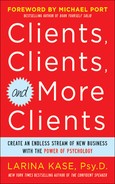Chapter 7
Give Value—People Quickly Determine Whether Something Is Helpful
Try not to become a man of success but a man of value.
—ALBERT EINSTEIN
THERE’S A FASCINATING book called The Five Love Languages by Gary Chapman. Chapman says that everyone has a different way of communicating their love, either through
• Words of affirmation
• Quality time
• Gifts
• Acts of service
• Physical touch
Everybody speaks a different language that determines how they express and expect love. Let’s say that your significant other is expressive and she feels loved when you tell her how you feel. Her primary love language is words of affirmation. You, on the other hand, like to spend quality time together to show and feel love. You speak the language of quality time. Can you see how easily miscommunication can occur? Couples often get into conflicts and fall out of love with each other because they do not feel loved. You may be speaking a love language but your partner is not hearing it. The solution is to learn what language your partner speaks so you communicate your feelings in his or her language so your feelings get heard.
This is a book on business relationships, not love relationships, so how does all of this apply? It is the same, although the types of languages spoken are different. We need to learn what languages our business partners speak so we can communicate in the ways that are most valuable to them. This goes back to what their goals are and how you can help fill them, as we discussed in the first section.
In my work with clients and my own business partners, I see the five most common languages of love in business as
• Getting referrals. These professionals seek to build their businesses, and they love receiving referrals of their ideal clients.
• Saving time. These busy professionals value nothing more than time. They likely have several interests outside of work, such as family or sports, and their goal is to be as productive and efficient as possible in their work. They love anything that will save them time—and will love you if you can help them do that!
• Connecting people. These people love offering excellent referrals and recommendations to their clients or colleagues. They tend to be well-connected social influencers who appreciate knowing who’s the best in their field so they can connect people and resources.
• Adding intellectual value. These professionals always want to learn more. They love learning new and interesting things. They seek to maximize the quality of their work and the services they provide.
• Learning about favorite things. This language is more personal in nature; it’s about stuff they love, any personal thing that you know they are into—dogs, horses, kayaking, traveling, scrapbooking, whatever.
Which languages do you speak? What do you value most right now? Which languages do your referral partners speak? The only way that you can truly add value to your joint venture and referral partners is to understand the language that they speak.
People may have multiple love languages. Your goal is to discover which are the strongest for your referral partners and to customize your keep-in-touch marketing accordingly.
Your clients, unlike potential business partners, typically come to you for a specific service, so it is easier to understand the value that they are looking for. To speak their language is to provide the best possible quality service. Your keep-in-touch marketing will be directly in line with the type of content that they’re looking for.
One of my clients, Martina, a physical therapist, served patients with back injuries and had referral relationships with several chiropractors. Together Martina and I determined that her patients’ goals were to reduce their pain and increase their mobility. They wanted to feel comfortable with her, and they wanted to be served as efficiently as possible. She spoke their language by providing top-notch services and crystal clear descriptions (including written diagrams) of the exercises they would practice in between sessions. She increased her patients’ comfort level by making small talk, showing compassion and empathy, and mirroring their energy and talkativeness. If someone came in and said they were exhausted and spoke little, she helped them relax by remaining on the quieter side rather than peppering them with conversation. Martina met her patients’ goals for efficient service by keeping her practice on time unless there was an emergency. The front desk staff let patients know an accurate estimate for when they would be seen so they could do work or make a phone call while they waited if Martina was running behind.
Martina and I discovered that her chiropractor colleagues tended to speak two languages: referrals and time. The five or so chiropractors who referred most to her were relatively recent graduates with young families. They wanted to build their businesses and fill their schedules with referrals and save time so they could be with their children, play sports, and do other things. Martina learned about each of their backgrounds and specialties so she could provide patients who requested referrals for chiropractors with accurate information. She communicated efficiently with these chiropractors by immediately sending over her one-page treatment plan whenever they shared a patient (with the patient’s permission, of course, so the professionals could coordinate their care). She left succinct voice mails and included her phone number twice so the chiropractor wouldn’t need to listen to the message again if he or she missed a number.
